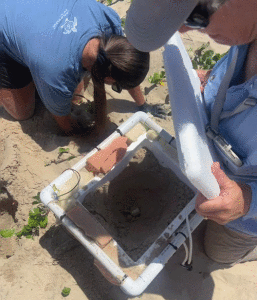
On Saturday morning June 8th, a call came through the 866-Turtle5 Hotline reporting a sea turtle nesting near the Big Jetty on Matagorda Peninsula. The caller, Billy Hegemeyer, said, “We watched her come up the beach, dig the nest, lay the eggs, and return to the water. We have lots of pictures and video.”
In the Hegemeyer’s videos, you can hear Sarah Hegemeyer describing exactly what they needed to do to keep the turtle and her eggs safe. Most importantly, the Hegemeyers kept their distance so the turtle wouldn’t get frightened back into the water without nesting. Only after the turtle layed her eggs and was returning to the water did they spring into action. They carefully laid sticks and debris in a wide circle around the nesting area and then they called for help.
Calling the Texas Sea Turtle Hotline and pressing 3 (for Matagorda, Espiritu Santo, and San Antonio Bays) gets you to the volunteer coordinator for San Antonio Bay Partnership’s Mid-Coast Sea Turtle Rescue here in Port O’Connor.
Our organization was started because of the 550+ sea turtles that died in 2021 Winter Storm Uri when there was no rescue in our area. Since then, we’ve built a corp of local volunteers who respond to help cold-stunned and stranded turtles. Getting a call about a nesting turtle wasn’t something we were prepared for, but with a couple of phone calls, Moriah Tyroch was on her way up from Corpus. As a staff member at Amos Rehabilitation Keep (ARK) and a volunteer at Padre Island National Seashore, Moriah is specially trained to find, dig up and transport sea turtle eggs.
On the Texas Coast, the primary nesting turtle is the Kemp’s Ridley, the smallest (2 ft, 70 to 100 lbs) and most endangered of the world’s seven sea turtle species. In the1970s the National Park Service at Padre Island National Seashore established a program to increase nesting and form a secondary nesting colony. (The main nesting beaches are in Mexico.) Dr. Donna Shaver, Division Chief, has spent over 40 years developing and running the program which collects, incubates, and releases turtle hatchlings back into the Gulf of Mexico.
When we arrived at the Hegemeyers home on the bay side of Matagorda Peninsula, they were excited to take us in their vehicles to the nest sight. Even with the nesting area well marked, it was a challenge finding the eggs. Using a stick, Moriah gently and methodically probed the sand feeling for the cavity. Once located, she removed the sand above it until she reached the first of the eggs. Gently, she removed each egg and placed them in the Styrofoam cooler that she had lined with cool sand. We all counted as each one was added. 80 eggs in total went into the cooler that was suspended by bungies within a PVC frame and padded with soft foam. Back to Port O’Connor and the eggs were placed in Moriah’s truck for her to deliver them to the specially designed incubation facility at the National Seashore near Corpus.
The park service conducts public releases and posts the announcements on the Hatchling Release Hotline (361) 949-7163 and on their social media pages.
If you would like to see a video of the Hegemeyer’s turtle nesting on Matagorda Peninsula, go to www.SABayPartnership.org/sea-turtle-rescue
Remember, if you see a sea turtle on a beach, dead or alive, call the Texas Sea Turtle Hotline 866-887-8535. All sea turtles are endangered, protected, and closely studied throughout the world.
Brigid Berger Texas Master Naturalist and Mid-Coast Sea Turtle Rescue Coordinator

Moriah Tyroch, ARK retrieves turtle eggs while Brigid Berger, MCSTR keeps them shaded.
